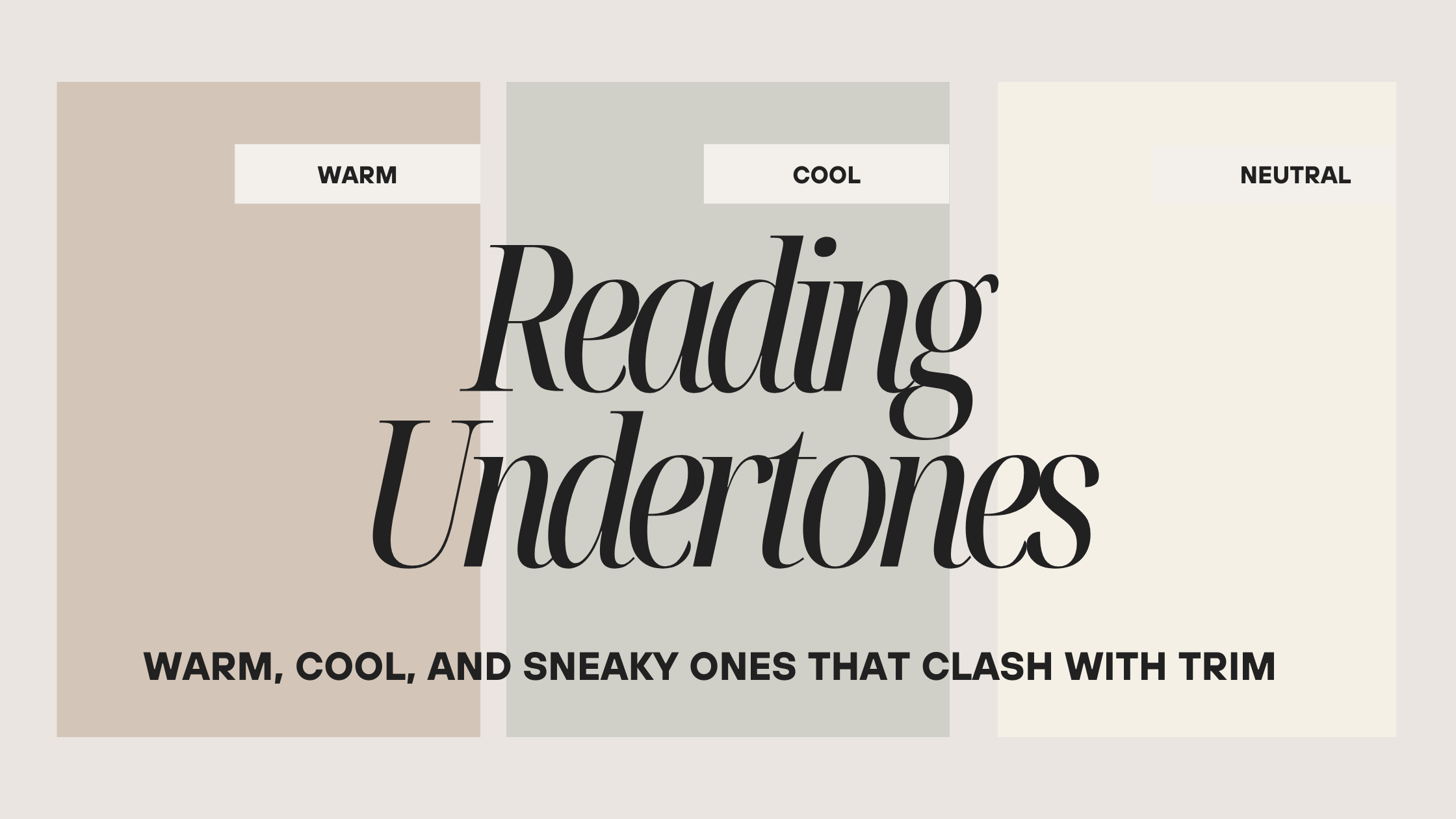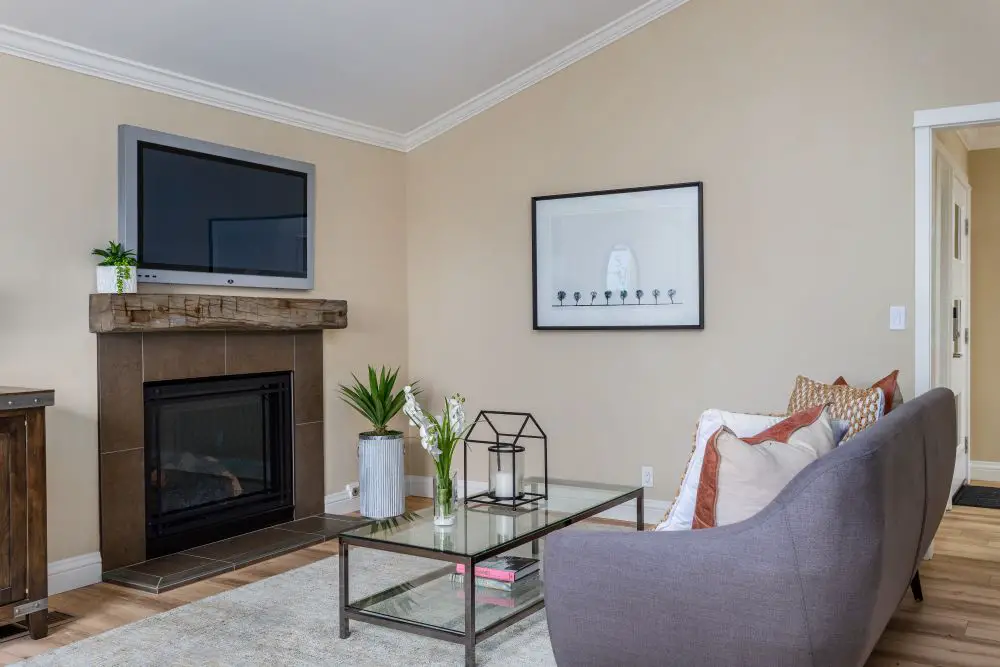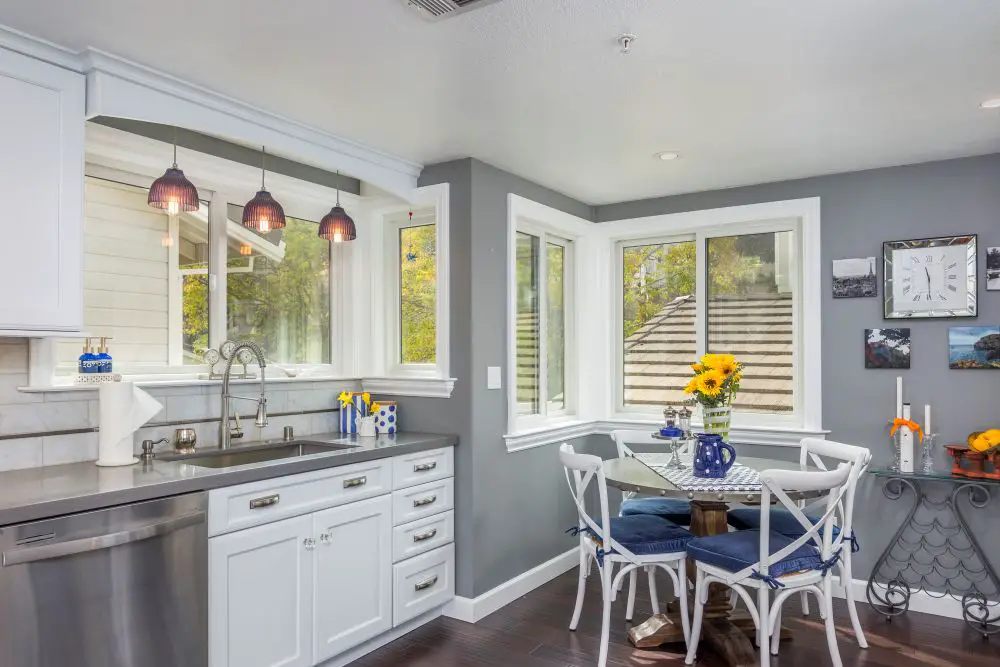By using our website, you agree to the use of cookies as described in our Cookie Policy
The Boss’s Daughter
Reading Undertones: Warm, Cool, and the Sneaky Ones That Clash With Trim

Reading Undertones: Warm, Cool, and the Sneaky Ones That Clash With Trim
You pick a swatch, you’re sure it’s “the one,” and then—next to the trim—it turns weird. Too yellow? A little blue? That “off” feeling is the paint’s undertone talking: the subtle hue hiding under the main color.
In this guide, we break down warm vs. cool undertones, how lighting shifts them, and the sneaky clashes that show up beside trim and fixed finishes. Then we’ll walk you through a simple, weekend-ready test so your walls feel right in real life—not just on the paint card.
What are paint undertones, and why do they matter for walls and trim?
Undertones appear once color meets the real world—trim, floors, tile, stone, and furniture all tease them out. A “pure” white on a card might read creamy next to cool gray tile. A safe greige can lean pink when it sits near warm oak floors.
Warm undertones carry red, orange, or yellow. Think creamy whites, beige with yellow, terracotta, camel, honey oak—inviting and cozy. They can warm up shadowy, north-facing rooms and family spaces that want a little sunshine.
Cool undertones carry blue, green, or violet. Think blue-gray, green-gray, crisp blues, charcoal with blue, icy whites—calm, airy, modern. They balance south-facing rooms that already run warm.
Neutrals still lean. Greige, off-white, and taupe always tilt one way. Greige can go warm or cool. Taupe can hide purple or pink. Off-whites swing creamy or icy. That’s why “safe” colors sometimes surprise you once trim and floors enter the chat.
Undertones shape mood and style: warm reads cozy and welcoming; cool reads calm and clean. To spot direction fast, compare two close chips side by side and ask which looks more yellow or more blue. That tiny nudge usually decides harmony.
Want a pro glossary? Sherwin-Williams explains it clearly: understanding paint undertones.
Warm undertones: cozy, sunny, and forgiving
Look for a yellow, red, or orange cast—creamy whites, sand beige, camel, terracotta, honey oak.
Warm walls shine in cool, north-facing rooms and busy family spaces; they soften shadows and feel lived in.
Heads up: Warm walls can make icy (blue-leaning) trim look harsh. If your trim is cool, choose a white with a touch of warmth or a true neutral white so they play nice.
Cool undertones: crisp, airy, and modern
Look for blue, green, or violet—blue-gray, green-gray, soft lavender, icy whites.
Cool colors balance sunny, south-facing rooms and bring spa-calm to bedrooms and baths.
Watch for this: Cool walls can make creamy trim read dingy or yellow. If your trim skews warm, try a neutral white or a warmer wall neutral so they share a family.
Neutrals still lean: greige, taupe, and off-white
Greige can go warm or cool. Taupe may hide purple or pink. Off-whites shift creamy or icy based on light and neighbors. These are the shades most likely to clash with trim and tile because we assume they’re neutral-neutral.
Line up three similar neutrals. One will look more yellow, one more pink, one more blue/green. Tiny on paper, huge on your wall.
Another approachable walk-through: Home on Station Hill’s Undertones 101.
How to read undertones like a pro in any room

Photo by Blue Bird
Here’s a weekend-ready system we use in East Bay homes:
Start with side-by-side comparison on plain white printer paper. That stark white reveals undertones faster than a single chip.
Check your lighting. Daylight and bulbs change the read. A balanced gray in-store can look green at home under 4000K bulbs.
Make large sample boards. Two coats on poster board with a crisp white border. Walk them around. Hold next to trim, floors, and stone. The border gives your eyes a true baseline.
Know LRV and sheen. LRV (Light Reflectance Value) tells you how much light a color bounces. High LRV = brighter; low LRV = moodier. Higher sheens reflect more and pick up nearby colors—trim sheen often makes undertones louder.
Good visual coaching on pairing wall and trim by undertone: Kylie M Interiors’ lesson on undertone & inspiration. Prefer to hand it off? We include recommendations and sampling with our professional interior painting services.
Compare method: line up chips and look for the hidden hue
- Gather 3–5 close shades on white paper; include at least one warmer and one cooler option.
- Say it out loud: more yellow, more blue, more green, a little pink? Naming it locks it in.
- Hold the group near floors, counters, tile, and your trim.
- Trust the set, not the single chip—our eyes read differences best in context.
Lighting check: daylight and bulbs can flip undertones
North-facing light runs cooler and can pull blue/gray forward (warms feel balanced, cools can get chilly). South-facing light runs warmer and can mellow cools while boosting warms (hello, greige-that-looks-beige at 3 p.m.).
Bulbs matter, too:
| Bulb Temperature | Common Label | How It Reads |
|---|---|---|
| 2700K–3000K | Warm white | Cozy; can yellow creamy whites |
| 3500K | Neutral white | Balanced; great for color judging |
| 4000K+ | Cool white | Crisp; can pull blue or green |
Test morning, noon, and evening. Choose for the time of day you actually use the room most.
Big samples and the white border trick
- Paint two coats on letter-size boards; label each.
- Leave a clean white border—it’s your neutral baseline.
- Move boards around and set them beside trim, doors, floors, and tile.
- Peel-and-stick swatches work, too—fast and tidy.
LRV and sheen: why reflectivity changes what we see
- LRV = how light/dark a color reads; higher LRV brightens, lower LRV deepens.
- Higher sheen (satin, semi-gloss) reflects surroundings and can amplify undertones.
- Trim is usually higher sheen than walls, so its undertone shows more.
- If trim looks too yellow/blue, it may be the sheen + light, not just the formula.
Feeling stuck? Our quick guide on overcoming paint paralysis will get you moving again.
The sneaky clashes: when walls and trim fight each other
Clashes happen when wall and trim undertones live on opposite sides. Warm walls with cool-white trim can feel sharp and chilly; cool grays with creamy trim can read dingy. Grays and greiges are repeat offenders—they hide blue, green, purple, or pink that retail lighting won’t reveal.
Fixed finishes steer the ship. Oak floors push yellow/orange into nearby colors. Marble veining can pull blue/green. The stronger the contrast, the louder the undertone reads.
The fix: Keep wall and trim in the same undertone family, or adjust just one notch warmer/cooler—not both. If something clashes, either warm/cool the trim white or shift the wall a half step.
For a bigger-picture refresher, ECOS Paints’ quick take on cool vs. warm paint colors is helpful.
The white trim trap: icy vs. creamy vs. true white
Icy (cool) white trim beside warm beige walls can look stark or slightly blue. Creamy (warm) trim beside cool gray walls can read yellow or dirty. True white is crisp but can feel too sharp next to very warm walls.
Solution: Match undertone families or step just one notch apart. If you want contrast, do it with lightness (LRV), not opposing undertones.
Gray and greige gotchas: blue-gray, green-gray, and pink-beige
Blue-gray walls + creamy trim = baby blue. Green-gray + pink-beige = muddy. Purple-leaning taupe + yellow-toned trim = bruised.
Pair cool grays with cool whites. Pair warm taupes with soft warm whites. Love a tricky greige? Sample it with your exact trim paint first.
Don’t forget the floors, tile, and countertops
Orange/red-stained wood floors push warmth into nearby colors and can make cool grays read green. Marble/quartz veining with blue/green/violet cools a space and can make warm off-whites feel extra creamy.
Always test wall and trim right next to these surfaces. The finishes you can’t change should drive your paint calls. Need a second set of eyes? We offer expert guidance on paint undertones.
Foolproof pairings and a simple checklist for undertone harmony
Reduce risk by picking a family (warm or cool) and keeping trim aligned. If you want contrast, make it about depth, not opposite undertones.
Kylie M Interiors shows where warm/cool partners can work—with balance: how undertone pairings behave.
Warm with warm: cozy combos that always work
- Soft beige walls + creamy soft-white trim (shared yellow base).
- Muted clay/terracotta walls + warm off-white trim (earthy, grounded).
- Sage-leaning green (touch of yellow) + warm off-white trim (gentle contrast).
They win because they share the same undertone family—nothing fights.
Choosing after a remodel? Our notes on tying finishes and paint together will help.
Cool with cool: crisp, clean, and fresh
- Pale blue or blue-gray walls + bright, cool-white trim (airy, modern).
- Misty green walls + neutral-to-cool white trim (spa calm, no mint).
- Soft lavender walls + cool white trim (avoids yellow cast).
Reliable for bedrooms and baths.
Balanced neutrals: easy greige and soft whites
- Greige that leans slightly warm + soft neutral white trim (cozy, not yellow).
- Light taupe + off-white trim sharing the same subtle undertone.
- Tip: Lots of cool materials? Choose a neutral white over creamy to prevent yellowing.
New to undertones? The visuals in Undertones 101 build quick confidence.
The 6-step undertone checklist
- Gather 3–5 close shades in the same family.
- Compare on white paper; name the undertone out loud.
- Paint large boards with a white border.
- Test beside trim, floors, tile, and counters.
- View morning/midday/evening and note bulb temperature.
- Match wall + trim undertones, or choose a neutral white that doesn’t fight.
Want help choosing or a finish that looks as good up close as it does in photos? Our crew specializes in crisp lines and clean cut-ins. And if decision fatigue creeps in, try our paint paralysis tips to get unstuck fast.
Undertones decide harmony. When you read the hidden hue, test it in your light, and match it to your trim and finishes, the whole room clicks. Big samples, smart comparisons, and a quick bulb check save time, money, and second coats.
Before you buy gallons, run the 6-step checklist. If you want backup, we can handle the sampling and the painting so you get the finish you pictured—without surprises.
‹ Back



Comments